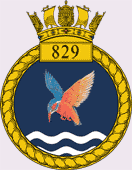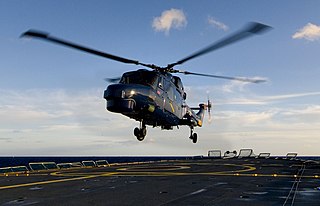Trials and Evaluation
Commanded by a trained Test Pilot, with an Aerosystems trained Observer as Executive Officer, both previously assigned to MoD Boscombe Down, the unit is well placed to act as the centre of excellence for trials activity within the LHF.

MoD Boscombe Down(ICAO: EGDM) is the home of a military aircraft testing site, located near the town of Amesbury in Wiltshire, England. The site is currently run, managed and operated by QinetiQ; the private defence company created as part of the breakup of the Defence Evaluation and Research Agency (DERA) in 2001 by the UK Ministry of Defence (MoD). It is also the home of the Empire Test Pilots' School (ETPS).
Recent trials include live guided missile firings (Lynx Mk8 S), operational evaluation of defensive aids suites (Lynx Mk8 DSP) and assessment of new NVG compatible landing lamps (Lynx Mk3). In addition the unit is providing SMEs to the SCMR / Future Lynx (FLynx) programme as part of the LHF SCMR Fielding Team’s involvement in the FLynx Combined Test Team. Such activity involves close liaison with many external agencies, such as the MOD's Lynx Integrated Project Team, AgustaWestland and Boscombe Down (Mission Systems and Rotary Wing Test Squadron).

The Ministry of Defence is the British government department responsible for implementing the defence policy set by Her Majesty's Government and is the headquarters of the British Armed Forces.

AgustaWestland was a helicopter design and manufacturing company. It is a wholly owned subsidiary of Leonardo S.p.A.. It was formed in July 2000 as an Anglo-Italian multinational company, when Finmeccanica and GKN merged their respective helicopter subsidiaries to form AgustaWestland, with each holding a 50% share. Finmeccanica acquired GKN's stake in AgustaWestland in 2004.
RWTS redirects here. For a low-level disk I/O subroutine, see Read/Write Track Sector

The Fleet Air Arm (FAA) is one of the five fighting arms of the Royal Navy. and is responsible for the operation of naval aircraft. The Fleet Air Arm recently started operating the F-35 Lightning II in a Maritime Strike Role, the AW159 Wildcat and AW101 Merlin in both Commando and Anti-Submarine roles, and the BAE Hawk. Helicopters such as the Lynx and Westland Wasp were previously deployed on smaller vessels since 1964, taking over the roles once performed by biplanes such as the Fairey Swordfish.

The Westland Wasp was a small 1960s British turbine powered, shipboard anti-submarine helicopter. Produced by Westland Helicopters, it came from the same P.531 programme as the British Army Westland Scout, and was based on the earlier piston-engined Saunders-Roe Skeeter. It fulfilled the requirement of the Royal Navy for a helicopter small enough to land on the deck of a frigate and carry a useful load of two homing torpedoes.

The Westland WS-61 Sea King is a British licence-built version of the American Sikorsky S-61 helicopter of the same name, built by Westland Helicopters. The aircraft differs considerably from the American version, with Rolls-Royce Gnome engines, British-made anti-submarine warfare systems and a fully computerised flight control system. The Sea King was primarily designed for performing anti-submarine warfare (ASW) missions. A Sea King variant was adapted by Westland as troop transport known as the Commando.

Royal Naval Air Station Yeovilton, or RNAS Yeovilton, is an airfield of the Royal Navy and British Army, sited a few miles north of Yeovil, Somerset. It is one of two active Fleet Air Arm bases and is currently home to the Royal Navy Wildcat HMA2 and Army Air Corps Wildcat AH1 helicopters as well as the Royal Navy's Commando Helicopter Force Merlin HCi3/3A/4 and Wildcat AH1 helicopters.

Royal Naval Air Station Culdrose is a Royal Navy airbase near Helston on the Lizard Peninsula of Cornwall UK, and is the largest helicopter base in Europe. Its main role is serving the Fleet Air Arm's front line Merlin helicopter squadrons.

The Black Cats are the Royal Navy's helicopter display team. The team is composed of two AgustaWestland Wildcat HMA.2 anti-submarine and anti-shipping helicopters, with the aircraft and crews drawn from 825 Naval Air Squadron based at RNAS Yeovilton in Somerset.

700 Naval Air Squadron is a squadron of aircraft in the Royal Navy’s Fleet Air Arm.

817 Squadron was a Royal Australian Navy Fleet Air Arm squadron. It was originally formed as part of the Royal Navy's Fleet Air Arm for service during World War II and took part in combat operations in Norway, North Africa, Sicily and off the coast of France. Following the conclusion of hostilities, the squadron was disbanded in 1945. In 1950, it was re-raised as part of the Royal Australian Navy and subsequently took part in the Korean War. Recent deployments have included Operation Falconer, Operation Slipper and Operation Sumatra Assist. In December 2011, the squadron was disbanded.

702 Naval Air Squadron was a naval squadron of the Royal Navy's Fleet Air Arm. It was based at RNAS Yeovilton in Somerset. As a training Squadron it trained all ground and air crew for the sister front-line maritime Lynx squadron, 815 NAS

723 Squadron is a Royal Australian Navy Fleet Air Arm squadron. The squadron was first raised in 1952 and throughout its history has served operationally during the Vietnam War, the Gulf War and in East Timor. It currently operates as a helicopter training squadron and is based at HMAS Albatross at Nowra, New South Wales.

The Air Warfare Centre (AWC) is a Royal Air Force research and testing organisation based at RAF Waddington in Lincolnshire. It has a training branch nearby as a lodger unit of RAF Cranwell and other branches elsewhere, including at RAF High Wycombe, RAF Brize Norton, MOD Boscombe Down, and RAF Odiham.

829 Naval Air Squadron was a squadron of the Royal Navy Fleet Air Arm. Before it was decommissioned in March 2018, it operated the AgustaWestland Merlin HM2 helicopter.

The Danish Navy Air Squadron, was the aerial component of the Danish navy, from 1977 to December 31, 2010. Operationally it was directly under command of the Danish Naval Command, but maintenance of the eight Westland Lynx helicopters and training of personnel was in cooperation with the air force. The helicopters were used primarily for fishery patrol, shipboard support and coastal Search & Rescue (SAR) missions.

725 Squadron is a naval aviation squadron of the Royal Australian Navy (RAN) Fleet Air Arm. The squadron was originally created in August 1943 as part of the Fleet Air Arm of the Royal Navy. It initially served as a fleet requirements unit, was rerolled in August 1945 as a target towing unit, then was disbanded in December 1945. In January 1958, the squadron was re-formed, as a fleet requirements and communications unit of the RAN, operating a variety of fixed-wing aircraft. The squadron was redesignated as an anti-submarine warfare training squadron in May 1959, then was decommissioned in May 1961 and absorbed into 724 Squadron. 725 Squadron was recommissioned in November 1962 as an operational anti-submarine helicopter squadron, flying the Westland Wessex. During this commission, the squadron was involved in HMAS Sydney's troop transport voyages, the rescue of personnel following the Melbourne-Voyager collision, and the Operation Navy Help Darwin relief effort post-Cyclone Tracy. The squadron was decommissioned in December 1975. 725 Squadron was commissioned for the fourth time in June 2015, this time as a training unit for MH-60R Seahawk Romeo helicopters: the squadron had been reactivated two years prior as a non-commissioned unit train on and accept into service the Romeos.

705 Naval Air Squadron was first formed as a flight in 1936 from No 447 Flight Royal Air Force and operated Swordfish torpedo bombers from battlecruisers. It achieved squadron status in 1939 before being disbanded in 1940. The squadron was re-formed briefly in 1945 and then again in 1947 as a fleet requirements unit to evaluate naval use of helicopters. Since the 1950s the squadron has been involved in the basic training of helicopter aircrew, and currently forms part of the Defence Helicopter Flying School at RAF Shawbury.

The AgustaWestland AW159 Wildcat is an improved version of the Westland Super Lynx military helicopter designed to serve in the battlefield utility, search and rescue and anti-surface warfare roles. In British service, common variants are being operated by both the Royal Navy and British Army, having replaced their Lynx Mk.7/8/9 predecessors. The AW159 has also been offered to several export customers, and has been ordered by the Republic of Korea Navy and the Philippine Navy.






















